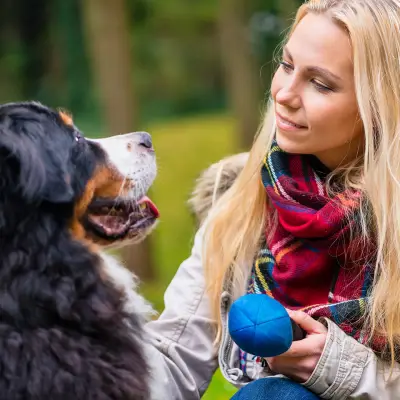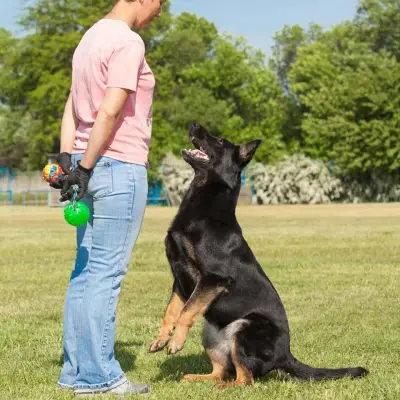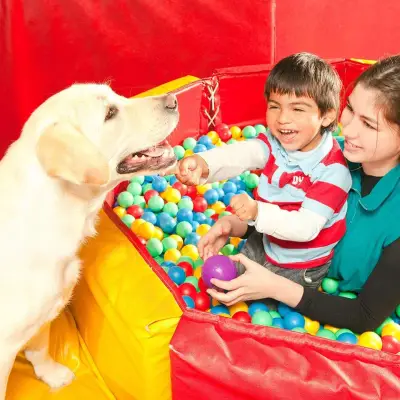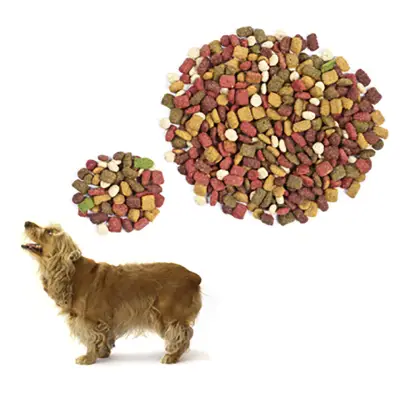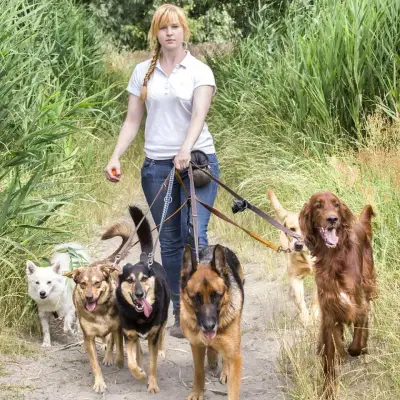Dogs begging for food is one of the most common complaints owners mention. Left unchecked, it can lead to nuisance behaviours such as whining, pawing, jumping on guests, or even stealing from kitchen counters.
You might be looking into this topic because you value peaceful mealtimes, you worry about your dog’s waistline, or you simply want to reinforce polite manners. Whatever the reason, you’ll find easy-to-apply strategies below that work for puppies and seasoned snack-thieves alike.
Jump to:
- Why Do Dogs Beg for Food?
- Instinct Versus Learned Behaviour
- The Downsides of Begging
- Practical Steps to Stop a Dog From Begging for Food
- Common Mistakes to Avoid
- Tackling Counter Surfing and Food Stealing
- Recognising Hunger Versus Greed
- When to Seek Professional Help
- Summary Checklist
- Study Our Dog Training Diploma for £29
Recommended for you!
Best SellersWhy Do Dogs Beg for Food?
Dogs beg for food because it works. A dog offers a hopeful stare, you give a scrap, and the behaviour is instantly rewarded. Over time, this becomes a habit. Dogs are opportunists by nature; wild canines survived on scavenged leftovers, so the behaviour is rooted in evolution.
Modern living has merely moved the scavenging from campfires to kitchen tables. Some dogs also learn that begging brings attention—even a reprimand is attention, and attention is valuable to a social species.
Instinct Versus Learned Behaviour
Survival instincts make food a top priority for dogs, so instinct does play a part in food-begging. Yet if your dog is constantly begging for food, this is usually an owner-reinforced habit. Puppies that are never rewarded for begging rarely grow into adults that pester at mealtimes.
Begging is a learned behaviour that forms through repetition and reward, often unintentionally on the owner’s part. The good news is that with consistency and the right approach, it can be just as effectively unlearned.
The Downsides of Begging
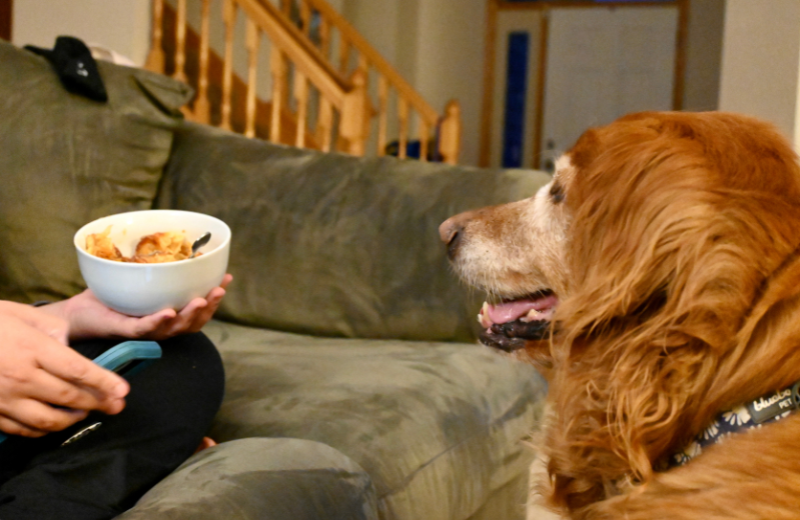
Allowing begging seems harmless, but it can spiral into:
- Unhealthy weight gain – extra calories add up quickly
- Diet imbalance – rich human foods may upset digestion
- Resource-guarding – a dog that expects table scraps may guard them fiercely
- Unsafe ‘counter surfing’ – dogs may steal sharp-toothed bones or toxic foods such as onions and chocolate
Practical Steps to Stop a Dog From Begging for Food
The key to stopping dogs begging for food is teaching them a more appropriate behaviour. Below is a step-by-step guide that combines structure, reward, and consistency.
Step 1: Teach a Settle on a Mat
Start by designating a mat or blanket as your dog’s ‘mealtime spot’. Cue “bed” before you sit down to eat. When your dog lies on the mat, calmly give them a chew toy or stuffed Kong to occupy them. This shifts their focus away from your plate.
Have a few small treats on hand. Sit at the table and wait for the dog to glance away or lie down on their own. The moment they do, mark the behaviour with “yes” and place a treat on the mat. Repeat this until your dog learns that not staring or pawing brings rewards.
Step 2: Build Duration and Resistance
Once your dog understands the basic concept, you can begin to increase how long they stay calm before earning a treat. Start by rewarding every five seconds of quiet, settled behaviour, then move up to ten, then twenty. If they leave the mat or start whining, ignore the behaviour and wait for calm again before resuming rewards.
As your dog gets better at this, introduce distractions such as family meals, guests, or the smell of a roast dinner. Gradually, your dog will learn how to handle these situations without jumping up or whining.
Step 3: Reduce Treats Over Time
Once your dog reliably stays calm during meals, you can reduce food rewards. Swap them for verbal praise or a gentle stroke, or use a favourite toy as a reward. Eventually, the behaviour becomes second nature and won’t need constant reinforcement.
If your dog still gets overly excited at meal times, try a scatter-feed technique. Toss some kibble in the garden or on a snuffle mat before dinner. It encourages natural foraging behaviour and burns off some of that frantic energy.
Step 4: Manage the Environment
While training is underway, it helps to minimise temptations. Close kitchen doors, use baby gates, or crate your dog during preparation and serving times. This prevents them from rehearsing bad habits like counter surfing or stealing.
Step 5: Ignore Attention-Seeking
Eye contact, scolding, and pushing your dog away all register as attention, which can accidentally reward the behaviour. Instead, wait for silence or calm, then toss a treat toward the mat without saying anything. This rewards the good behaviour quietly and effectively.
Step 6: Get Everyone on Board
Make sure all members of the household follow the same rules. If one person occasionally sneaks a scrap under the table, it undermines the entire training process. A united front sends a clear, consistent message that begging doesn’t work.
Common Mistakes to Avoid
- Inconsistent rules – one family member sneaks tidbits and undoes your progress
- Punishment after the fact – scolding a dog for stolen food seconds later confuses them
- Reinforcing whines – saying “quiet!” while looking at the dog rewards attention-seeking
Tackling Counter Surfing and Food Stealing
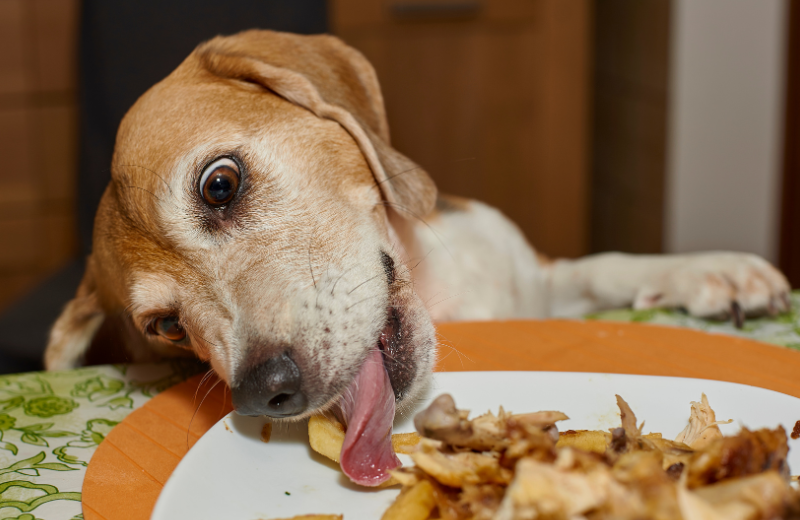
If your dog isn’t just begging but actively helping themselves to food, you may be facing issues like counter surfing or stealing from tables and bins. Here are some practical strategies to help prevent and manage this behaviour:
- Remove temptation – clear worktops and bins, close the dishwasher
- Block access – fit safety gates or keep the dog behind a baby pen while cooking
- Interrupt and redirect – if you see a paw lifting, call the dog to their mat for a reward before they reach the surface
- Teach impulse control games – “leave it”, “wait”, and food-bowl Zen exercises build self-control
- Avoid punishment – use management and reward-based training; harsh scolding can increase anxiety and sneaky behaviour
Recognising Hunger Versus Greed
True hunger and food-seeking behaviour often look similar, but they aren’t always driven by the same need. A useful way to assess this is by checking your dog’s body condition—ribs should be easy to feel but not visible.
If a dog is a healthy weight yet still appears desperate for food, the behaviour may stem from excitement during meal preparation, which can be addressed through consistent training. In other cases, ongoing food obsession may be linked to underlying medical issues such as diabetes or Cushing’s disease, which require veterinary attention.
Food-focused behaviour can also be a sign of boredom, especially if the dog lacks regular mental and physical stimulation throughout the day.
When to Seek Professional Help
Most food-related behaviours can be managed at home with time, consistency, and simple training techniques. However, there are situations where professional support is important to ensure your dog’s safety and wellbeing:
- Begging escalates to growling or snapping: If your dog becomes aggressive when refused food, this could indicate anxiety or frustration around mealtimes. It’s important to address this early with the help of a qualified behaviourist.
- The dog guards stolen items: Dogs that snatch food and then growl, stiffen, or snap when approached may be showing signs of resource guarding. A behaviourist can help modify this behaviour safely and effectively.
- There’s sudden, unexplained weight loss or gain: Noticeable changes in weight could point to underlying medical issues such as diabetes, thyroid problems, and digestive disorders. A vet check-up is essential to rule out any health concerns.
Summary Checklist
✔ Feed measured meals on schedule
✔ Provide a chew or puzzle feeder during human mealtimes
✔ Ignore begging; reward calmness
✔ Prevent access to worktops and bins
✔ Train “bed”, “leave it”, and “wait”
✔ Stay consistent—every snack counts
Recommended for you!
Best SellersStudy Our Dog Training Diploma for £29
If you're ready to deepen your understanding and become a confident, knowledgeable trainer, consider taking the Dog Training Diploma Course with Centre of Excellence. Whether you're a dog owner, aspiring trainer, or simply passionate about canine behaviour, this course offers comprehensive guidance suitable for all levels. And right now, you can enrol for just £29.

